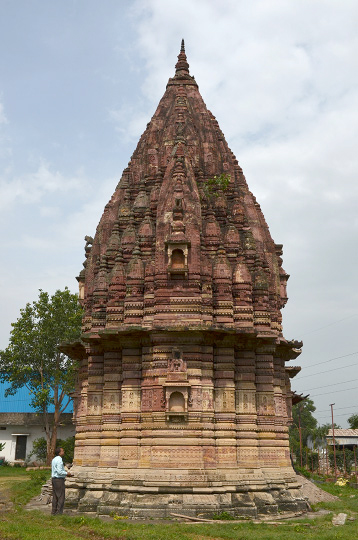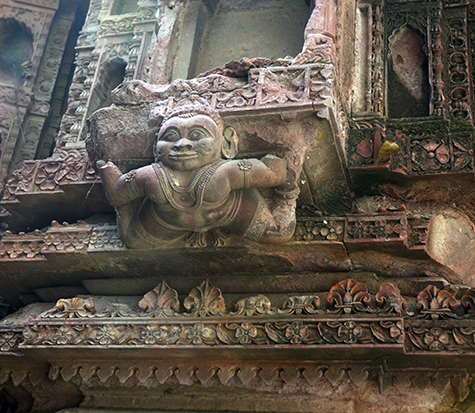 West view of the Murlidhar temple at Pardi, built during the Bhosle period, in the late 18th century, Nagpur.An American art history professor could help India preserve some historic religious sculpture and architecture.
West view of the Murlidhar temple at Pardi, built during the Bhosle period, in the late 18th century, Nagpur.An American art history professor could help India preserve some historic religious sculpture and architecture.
Cathleen Cummings, Ph.D., associate professor of art history at the University of Alabama at Birmingham, just returned from a research trip in India. Cummings, who teaches in the College of Arts and Sciences’ Department of Art and Art History, traveled for part of the fall semester on a fellowship from the American Institute of Indian Studies, the largest fellowship-granting organization for research in India. The AIIS selects senior and junior scholars for yearlong or short-term grants. Selection of fellows is rigorous, carried out once a year in a marathon session by a panel of scholars drawn from a variety of institutions and representing a careful disciplinary and gender balance.
|
Cummings has created what she believes to be the first contemporary, legible record of what was built, when, and where it is located. “I am trying to put GPS coordinates on everything that I can so that ultimately I can create a heritage map so these can be tracked from here going forward.” |
Cummings traveled to Nagpur, the capital city of the Bhosle dynasty, one of the five ruling families that made up the Maratha confederacy in the 18th century. She went to study Maratha temple architecture under the Nagpur Bhosles from 1740-1853. The temples are an understudied but important part of Hindu architecture and sculpture in stone.
The large number of structures built within the relatively short time span of the Bhosle rule for the purpose of religious activity indicates that a major program of temple-building was crucial to the creation and development of the city of Nagpur itself.
Cummings is interested in not just the iconography on the temples themselves but also whole patterns of temple building, as well as the formation of Nagpur as a city. Unlike many other places and cities in India, Nagpur, although it had been a small town for a long time, really developed as a city only at that time in the 18th century.
“It’s a place where we can track the development as a city. It is much more visible than a number of places,” Cummings said.
 Damaged sculpture of a gana — a type of attendant figure — on the exterior of the Lakshminarayana temple, one of three temples at the Kelibaug temple complex, built by KingRaghuji II and his fourth wife, Bakabai, between 1778-1781, in Nagpur.Cummings is working to track down and document the monuments that are still surviving, which is not easy to do. The 18th century is considered to be extraordinarily late for Hindu temple architecture, mainly due to the way the history, and art history, of India has been written since the colonial period. A lot of Hindu temple culture from the 18th and 19th centuries has been completely deleted from the art historical record — thought to be so late that it is not worth the bother — so that is something that people now are starting to reclaim, Cummings said, “but it is a slow process.”
Damaged sculpture of a gana — a type of attendant figure — on the exterior of the Lakshminarayana temple, one of three temples at the Kelibaug temple complex, built by KingRaghuji II and his fourth wife, Bakabai, between 1778-1781, in Nagpur.Cummings is working to track down and document the monuments that are still surviving, which is not easy to do. The 18th century is considered to be extraordinarily late for Hindu temple architecture, mainly due to the way the history, and art history, of India has been written since the colonial period. A lot of Hindu temple culture from the 18th and 19th centuries has been completely deleted from the art historical record — thought to be so late that it is not worth the bother — so that is something that people now are starting to reclaim, Cummings said, “but it is a slow process.”
Many of the temples there are privately owned. Some in India are unaware of the valuable heritage often hidden in people’s backyards, though there are people who are interested in heritage and history and they understand the importance of these monuments.
“Names have changed, location names have changed, many of them have structurally changed or been completely demolished,” Cummings said.
Nagpur, like many other cities in India, is trying to combat encroachment. People who want to build something just build it, she says. There is no enforcement of permits or zoning laws. Hundreds of shrines have been destroyed.
“Apart from trying to track the temples down, what this recent grant trip has made me aware of is how very precarious the situation with many of these very important heritage structures is in Nagpur right now,” Cummings said.
Cummings gave as example one temple she tracked down after seeing it referenced. The inner portion of the temple, the shrine, still survived; but a block of flats had been built on top of and around it, and the temple tower and mandapa were knocked down. The shrine, still in use, is accessible only through a side entrance to the parking area.
Cummings has created what she believes to be the first contemporary, legible record of what was built, when, and where it is located.
“I am trying to put GPS coordinates on everything that I can so that ultimately I can create a heritage map so these can be tracked from here going forward,” she said. Publicizing her work and the locations of the temples could be key to raising awareness and money to protect the temples.